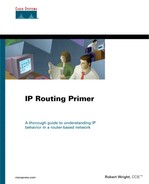Using Aggregation as a Tool
Summarization has already been introduced as a function that routers running RIP and IGRP perform when sending routing advertisements over interfaces whose IP addresses are in different major nets than the routes being advertised.
In the following scenario, aggregation will be manually configured to avoid sending unnecessary routing advertisements to certain routers. This can be done by using access lists to block the advertisement of certain subnets (see Figure 3-16).
Figure 3-16. Summarization reduces the content fo routing advertisements

Figure 3-16 also introduces a classic hierarchical design for building networks and implementing IP addresses. RouterA, RouterB, RouterF, and RouterG are remote sites. RouterC and RouterH are distribution sites. RouterD and RouterE are core routers. Any traffic from RouterA or RouterB that is destined for RouterF or RouterG must go through the distribution and core routers, and vice versa.
The goal for this scenario is to have full connectivity while advertising only a few subnets. Each router should have only as much routing information as absolutely necessary.
The FDDI ring has 10.0.0.0 assigned to it. RouterD and RouterE each advertise this major net to their distribution routers, which accept it as a major net advertisement. The distribution routers advertise this major net to their respective remote routers, which also accept it as a major net advertisement.
All distribution and remote routers are configured to use their routes to 10.0.0.0 to forward packets for networks they have no knowledge of. The method for doing this is explained in more detail in Chapter 5, "Default Routing."
The distribution routers must know about the subnets their remote routers have configured. RouterC must know that RouterA has 168.71.1.16 and that RouterB has 168.71.1.32. This can be done by manually configuring these routes into RouterC or by allowing RouterA and RouterB to advertise their networks to RouterC. RouterC already knows it is connected to 168.71.1.48.
In any case, RouterC only needs to advertise subnet 168.71.1.0 to RouterD because all subnets that start with the prefix 168.71.1.0 are in some way reachable via RouterC. The same holds for RouterH—it only has to advertise the prefix 168.71.2.0 to RouterE because all subnets with this prefix are reachable via RouterH. Only RouterD and RouterE need to know how to reach prefixes 168.71.1.0 and 168.71.2.0.
You can see that, in this design, all packets for subnets that the distribution and remote routers have no knowledge of will eventually arrive at the core routers. The core routers will drop any packets destined to subnets that they have no knowledge of.
It is imperative that the core routers are not configured to send any packets for subnets they have no knowledge of to each other—this would result in a loop.
This scenario shows how careful use of subnetting at distribution and remote sites can greatly reduce the amount of routing information necessary to maintain full connectivity throughout a network.
